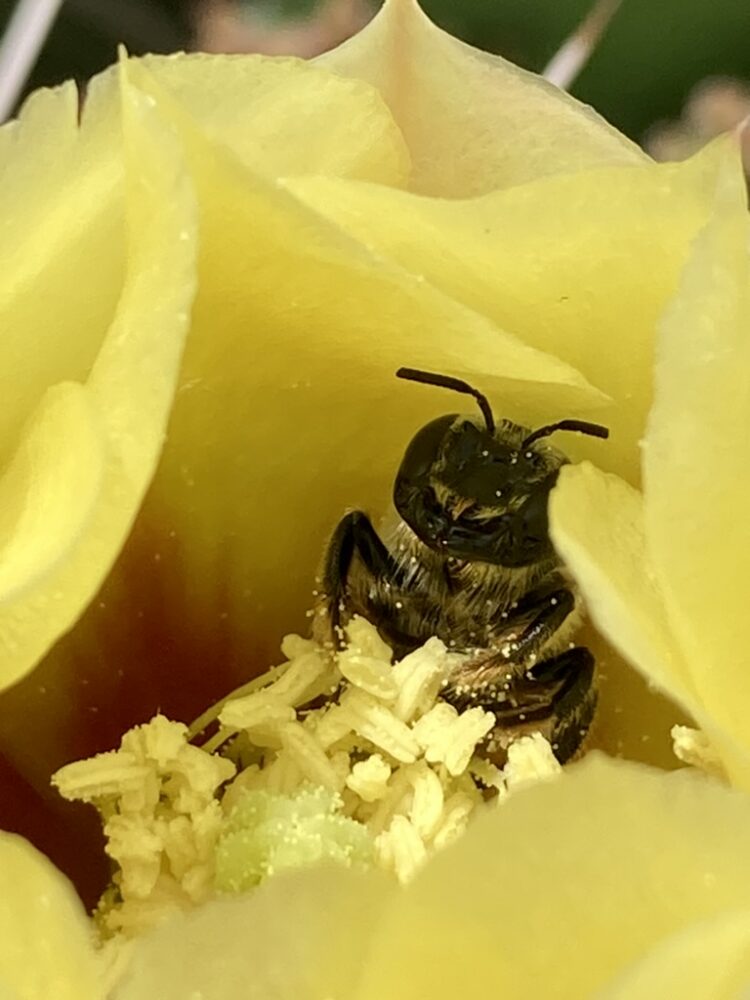
A specialist Cactus Bee hard at work in White Rock, NM | Photo Dana Ecelberger
Sometimes it can feel like we have to completely redo our landscapes in order to help pollinators, but this isn’t true. You can help pollinators by adding even a few plants of special benefit. A garden doesn’t have to be strictly native to provide valuable resources to our native bees and butterflies, wasps and moths and birds. Of course, the more wild, native areas we have the better it is for all of our wildlife, but that isn’t always practical or possible. In urban areas, it can be almost as beneficial to create lots of small, connected gardens so that pollinators can easily forage close to their nests. You might have a group of Firecracker Penstemons in your yard while your neighbor might have a patch of Maximilian Sunflowers and the arroyo behind your houses may have a wild abundance of asters. These small islands of resources located close to one another can become a pollinator oasis. And, the more we consciously create these dedicated plantings, the larger that oasis becomes. This is the reason we started the Backyard Pollinator Garden Project: to create continuity of pollinator plantings across Los Alamos County. To find out how you can participate, click HERE.
Many of our native bees are what are known as generalists. This means they can collect pollen from a wide variety of plants, including many non-natives like Lavender and Blue Spirea. Bumblebees are one of our most visible generalist bees. You will see them visiting Larkspur, non-native Hyssops and other herbs and a wide variety of flowering plants, as well as lots of our native flowering plants. If only we could ask them which ones they like best!
Most of our native moth and butterfly species will make use of both native and non-native plants with nice large, preferably flat, flowers. Flatter flowers make nice landing pads where they can comfortably access nectar, which is what they are really after. Moving pollen is not their concern. It is more of an accidental service they provide when foraging for the sweet nectar many flowers produce to entice pollinators. There are a number of moths and butterflies that rely on native plants for their larvae.
Specialist bees, by contrast, utilize only a very limited selection of plants. Squash bees, cactus bees and globemallow bees are examples of specialization. They only visit those plants and, therefore, the plants and bees are extremely dependent upon one another for survival. Planting any of those plants will greatly benefit specialist bees.
You can find out more about how to incorporate native plants into your existing or new gardens by visiting this presentation put together by our Bee City Los Alamos coordinator, Dana Ecelberger, for the 2024 Master Gardener Conference held at Fuller Lodge: How to Incorporate Native Pollinator Plants into Home & Municipal Landscapes
In the presentation, there are lists of plants that benefit specialist and generalist bees, divided into early, mid-season and late season bloomers so you can plant for a continuous bloom period. Some suggestions for non-invasive non-natives are also included.
Whether your garden is large or small, you can make a difference for pollinators. If you only have room to plant a few Goldenrods in pots on a deck, you will still make some little bee’s day!
Be sure to sign up for our newsletter so you can be sure to hear about all the great things we are doing in Los Alamos to protect and promote pollinators. You can find the sign up form at the bottom of the home page: www.beecitylosalamos.org

If you don’t have a garden but can plant native plants in containers on your balcony, that would also help with declining pollinator population, especially if you neighbors do the same. You can check out seeds from our Seed Libraries located at MPL, WR Branch, and PEEC. LA Community Seed Library is also planning a panel discussion on “Small Space Gardening” on Saturday, February 15th, 2025, 11 AM-12:30 PM in the upstairs rotunda. More information will be sent out closer to the date.